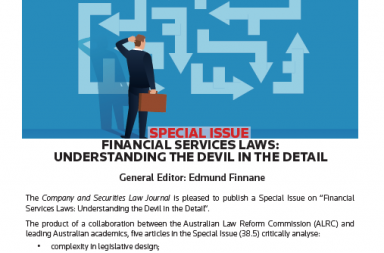*Please note that the links to the content in this Part will direct you to Westlaw AU.
To purchase an article, please email: [email protected] or contact us on 1300 304 195 (Australian customers) or +61 2 8587 7980 (international customers) during business hours (Mon-Fri, 8am-6pm AST).
The latest issue of the Journal of Judicial Administration (Volume 29 Part 3) contains the following material:
Articles
Single Joint Expert Witnesses – Ian Freckelton QC
After the 1995 Lord Woolf report into access to justice, there was increased international recognition of the risk that expert opinion evidence was too often coming before courts in ways that did not assist accurate fact-finding and that it was unacceptably expensive and prone to abuse. A number of initiatives were trialled, including single joint expert (SJE) witnesses. This article scrutinises the SJE procedure, which of its nature removes from parties the entitlement to choose and call their own expert witnesses. It highlights controversies in relation to the procedure and examines variations from jurisdiction to jurisdiction in how it is formulated and implemented. It suggests that, given other developments in relation to expert evidence procedure and admissibility, the era of SJE witnesses may have passed save in particular cases where it is necessary for courts to intervene to prevent abuse arising from the calling of a proliferation of experts by parties or where there is an absence of diversity of approach in the area of expertise.
Court Delay and Judicial Wellbeing: Lessons from Self-Determination Theory to Enhance Court Timeliness in Australia – Sarah Murray, Ian Murray and Tamara Tulich
Drawing on the experience in Australia of media criticism of judicial timeliness, this article uses the lessons of psychology and self-determination theory to suggest how judicial performance mechanisms should be designed to align intrinsic and extrinsic judicial motivation. Most crucially, measures of judicial performance need to be crafted with an acceptance of the fact that extrinsic motivation can lead to a reduction in the intrinsic motivation of judges. This means that court structures and processes should look to service judges’ psychological needs of competence, relatedness and autonomy. These can, for example, influence more collaborative ways of assigning cases, self-regulated performance goals, and mechanisms to promote judicial collegiality and mentoring. Approaches that solely concentrate on externally derived key performance indicators are likely to be deleterious to judicial productivity and wellbeing over the long term and will negatively impact on the timeliness of courts.
A Tale of Two Courts – Felicity Bell
For 20 years, two Australian Courts have been tasked with hearing family law matters: the Family Court and the Federal Circuit Court. In a jurisdiction dealing largely with relationship breakdown, relations between these Courts, and between they and the Federal Government, have not always been easy. But amid the politics of family law reform these spats raise larger questions about both the nature of family law and the nature of being a judicial officer. Specifically, the need for and importance attached to family law specialisation; and the relationships between trial and appellate courts, are considered.
Implications of the Royal Commission into Institutional Responses to Child Abuse for the Protection of Vulnerable Witnesses: Royal Commission Procedures and Introduction of Intermediaries and Ground Rules Hearings around Australia – Anita Mackay and Jacqueline Giuffrida
The Royal Commission into Institutional Responses to Child Abuse (CSARC) concluded in December 2017 after engaging with thousands of vulnerable witnesses over a four-year period. The first implication of the CSARC for the protection of vulnerable witnesses is innovative Royal Commission procedures that may be adopted by future Royal Commissions. The second implication is changes to criminal procedure in the States and Territories. The CSARC made a number of recommendations aimed at protecting vulnerable witnesses during criminal trials. This article focuses on two that relate to intermediaries and ground rules hearings, and the significant variation between jurisdictions in their approach to implementation of the recommendations. This article therefore recommends best practice for the use of intermediaries and ground rules hearings that could logically be incorporated into the Uniform Evidence scheme.
For the PDFÂ version of the table of contents, click here: JJA Vol 29 No 3 Contents.
Click here to access this Part on Westlaw AU
For general queries, please contact: [email protected].


